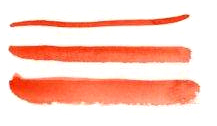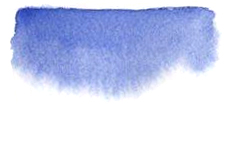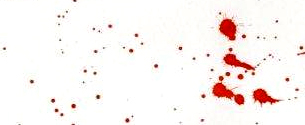Getting to Know Your Round Brush | "Learn to Watercolor" Lesson
from the Learn to Watercolor Index
Recommended Beginner Brushes
Brushes range in size from super tiny (000) to very big. If you are just getting started we recommend a #8 round brush. If you want an additional brush, a 1/2" flat wash brush is highly recommended. Make sure not to buy the really cheap ones. You'll be bummed that you did, and you'll have to go back to the store for another brush.
Basic Brush Technique
Get a jar of water, a paper towel, some watercolor paper, your paint set and your brand new brush, and plop yourself down at the kitchen table. It's time to see what your brush can do.
1) Long Lines
Begin by dipping your brush in your jar of water, and then in one of the pans of paint. Next, draw a long thin line. Don't stop drawing until you run out of paint. Fill your brush up with more paint and try it again. This time make the line wiggle.

2) Thin Lines/Thick Lines
Draw thin lines with the very tip of your round brush. Draw a thicker line by painting with the side of the brush. Press the side of the brush against the paper a little more and make the thickest stroke of all.

3) Wash
Washes are what make watercolor art magical. They are interesting and unpredictable. You can learn to control them to some degree, though learning to let them do what they want to do is part of becoming a good watercolor artist.
Draw a rectangle on your paper with clean water. Tip your paper slightly, and lay a thick line of blue paint along the top of the rectangle. Watch it "wash" down the rectangle. You just painted a sky!

4) Dry Brush
Dry brush technique gives paintings a scratchy look. It's quite different than a watercolor wash. Wet your brush, and then dry it on the paper towel. Next, fill it with paint and try a few strokes. Knowing how much water and paint is in your brush is an important part of being successful with dry brush technique.

5) Two Colors
Fill your brush with one color of paint and then dip the tip of the brush in another color. The color mixing that happens right on your paper will transform to your paintings!

6) Sketch
Try drawing a picture with the tip of your brush. (The technical term for this type of brushwork is calligraphy.)

7) Splatter
Try splattering the paint by flicking the brush, or tapping it against the index finger on your other hand. This technique will add some colorful and spontaneous effects to your artwork. (It's best to try this in a place where you won't ruin mom's furniture.)

Practice, practice, practice. You'll be great!

|